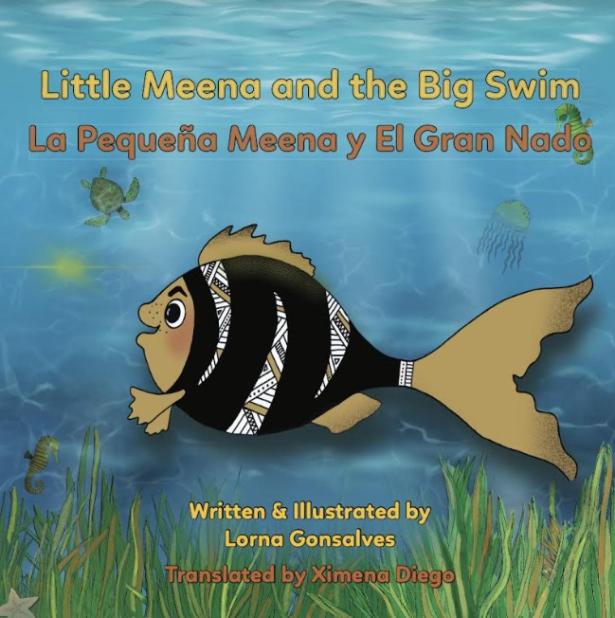books Little Fish, Big Fish and Bullies – a Review of Little Meena and the Big Swim
A single fish with a tear in her eye begins the story. Next page we see two fish, then an illustration of two fish imagining three, followed by the three imaging many. Turn the page again, now there are several groups of fish, after which the numbers grow so that the fish fill the whole page. Now, midway through the story, there is a different image, the three small fish with which we began are standing opposite three larger fish – who all look unfriendly. Turn the page again, now there are many smaller fish, far more than the mean big fish. A change is clearly riding a wave.
Little Meena and the Big Swim/La Pequeña Meena y El Gran Nado
Text & illustrations by Lorna Gonsalves/Translation by Ximena Diego
Book design by Matthew Tallon
Hard Ball & Little Heroes Press; 36 pages
Pa[erback: $13.50
April 27, 2024
ISBN: 979-8-9898025-1-7
...

How that change comes about is at the heart of Little Meena and the Big Swim. Author/illustrator Lorna Gonsalves children’s story tells a tale of how to respond when someone bigger and stronger is mean and unfair; it tells a tale of what a fish – or a child (or even an adult) – can do. Her story is timely and timeless, as she unfolds a simple truth that too often is forgotten.
The illustrations enable us to see further. All those little fish swarming together is appealing, and so one of the fish on the other side, swims over to join them. Not wanting to be mean, that fish now can make a choice – and does. Soon others swim over to the other side too, leaving those who wish to continue to be selfish swimming away, no longer able to bully. An image of two fishes hugging, followed by a picture filled with fish all together, smiling, sharing the food which should, after all, be common to all.
Turning the pages thereby tells the story of how to confront bullying – not by being “tougher” or “violent,” not by relying on a hero to come and save the day as in action movies, but by cooperation, by the little fish joining together.
Children can look, see, as the story tells itself in striking images. Gonsalves’ illustrations are bright and colorful, eye-catching so it is easy for young eyes to follow along. Looking closely, a reader can see that each fish is a little different, looking wide-eyed, readers can see other fish in the sea, can see and imagine the underwater world in which they live.
But the book is one that they can read as well for Gonsalves tells the story using simple, easy to follow words – and using simple explanations to define harder words. Explaining the plot behind the picture we learn that the mean fish won’t let Meena eat at a mound where she had gone in the past. She sees her friend Ridwan looking sad. He too has been turned away from the eating ground. Both of them are now hungry. Meena, remembering her grandmother’s stories about organizing a “Big Swim,” turns to her for advice. And, to quote from the book:
“She told them about the meaning of solidarity– about how swimming together with other fish who wanted to fix the same problem would make everyone stronger. ‘Wow! It sounds like solidarity gives you superpowers!’ Meena said.”
What follows tells us how they organized that “Big Swim” to get family, friends and friends of friends to take part. Or, rather, the story is told in two texts -- Spanish as well as English. The same story, different words. Thus, in one delightful book, a tale is told in three ways, visually and in two languages. That is itself a message.
Gonsalves has worked as a crisis counselor and youth advocate. That comes through in the book which, though written for young children, addresses a serious subject of bullying, bullying that comes with a real consequence too many suffer: hunger. Usually in children’s literature, the hurt depicted when a character is mean is about feelings alone. Such is important, but too often the social consequences are left out. Simalarly, the hero or heroine will solve the problems alone and then perhaps help their family or community. That, however, is a pathway that provides little guidance for the challenges most children will ever face. And absent social solutions, all too often a child or teenager will respond by turning inward by withdrawing or outward by lashing out.
The virtue of Gonsalves’ book is that she posits a different way forward, through cooperation and working together. Drawing on her experiences in India and the United States and her work through Creative Peaceful Resistance, a youth-centered grassroots organizing approach she conceived in 1999, Gonsalves points her readers into group problem solving. This is reinforced by discussion questions that follow the story, questions that can help even young children look at the outside world and not feel powerless within it. As the story concludes:
Everyone is full and free to eat on Rainbow Mound whenever they like. We won’t let greedy fish change that ever again!


Spread the word